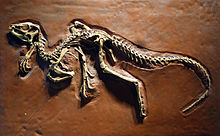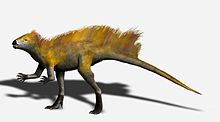畸齿龙科
| 畸齿龙科 | |
|---|---|

| |
| 加州大学古生物学博物馆的塔克畸齿龙标本SAM-PK-K1332 | |
| 科学分类 | |
| 界: | 动物界 Animalia |
| 门: | 脊索动物门 Chordata |
| 纲: | 蜥形纲 Sauropsida |
| 总目: | 恐龙总目 Dinosauria |
| 目: | †鸟臀目 Ornithischia |
| 科: | †畸齿龙科 Heterodontosauridae Romer, 1966 |
| 演化支 | |
畸齿龙科(Heterodontosauridae),又名异齿龙科,意为“有不同牙齿的蜥蜴”,是鸟臀目恐龙的一科,经常被认为是群基础鸟脚类恐龙,但近年研究显示畸齿龙科与头饰龙类关系密切。虽然畸齿龙科的化石很罕见,牠们从侏罗纪早期存活在全球各地,少数物种存活到白垩纪早期。
畸齿龙科的体型如狐狸般大小,身长少于2米。畸齿龙科因牠们的独特牙齿而著名,包括类似犬齿的长牙、以及适合咀嚼的颊齿,颊齿与白垩纪鸭嘴龙科的牙齿类似。畸齿龙科是草食性恐龙,或可能是杂食性。
描述
[编辑]在畸齿龙科中,只有畸齿龙发现了完整的骨骸。已发现醒龙的零散骨骸,但并没有完整的叙述,其他的畸齿龙科恐龙只有发现零散的下颌与牙齿。因此,大多数畸齿龙科恐龙的共有衍征来自于牙齿与颌部骨头[1][2]。畸齿龙的身长超过1米[3],但是狼鼻龙的零散化石显示牠们身长可达2倍[4]。

头颅骨
[编辑]醒龙与畸齿龙都有非常大的眼睛。眼睛之下的颧骨往两侧发展,这特征同时见于角龙下目恐龙。大多数鸟脚下目恐龙的前上颌骨前段是没有牙齿的,可能形成角质喙状嘴;但畸齿龙的前上颌骨前段具有牙齿。许多鸟脚下目恐龙的前上颌骨牙齿与上颌骨牙齿之间,有个大型牙缝,但畸齿龙科的这个牙缝呈现弓型。下颌的前段是前齿骨,前齿骨是鸟臀目恐龙特有的骨头。前齿骨也具有角质喙状嘴,类似前上颌骨。下颌的所有牙齿都在齿骨之上[1]。
牙齿
[编辑]
畸齿龙科恐龙的名称来自于牠们的异型齿齿列。牠们的前上颌骨有三种牙齿。生存于早侏罗纪的醒龙、畸齿龙、狼鼻龙,前上颌骨的两种牙齿是小而圆锥状的,而第三种较大的牙齿外表类似哺乳类食肉目的犬齿,这第三种牙齿常被称为犬齿形牙齿。下颌的犬齿形牙齿比上颌的大,并位在齿骨的第一个位置,在嘴部闭合时,可与上颌的弓型牙缝相符[1]。畸齿龙与狼鼻龙的犬齿形牙齿的前缘与后缘都是锯齿状的,而醒龙的犬齿形牙齿只有前缘是锯齿状的[5][6]。生存于早白垩纪的棘齿龙,上颌有两个犬齿形牙齿,并位在上颌骨而非前上颌骨[7];而存活在晚侏罗纪北美洲的果齿龙,下颌的齿骨可能共有两个犬齿形牙齿[8][9]。
如同独特的长牙,畸齿龙科恐龙的颊齿在早期鸟臀目中也是相当独特的,是个衍化特征。鸟臀目恐龙的颊齿位在颊部边缘,这些小型牙齿具有锯齿边缘,是用来咀嚼植被用。所有畸齿龙科恐龙的颊齿,离齿冠的前1/3段才有锯齿边缘;其他鸟臀目的颊齿,锯齿边缘从齿冠延伸到近齿根处。基础物种(例如醒龙)的颊齿位在上颌骨与齿骨,并类似其他鸟臀目恐龙的颊齿:占宽广空间、低齿冠、齿冠到齿根间有明显的舌面隆突(Cingulum)。更衍化的物种如狼鼻龙、畸齿龙,牠们的牙齿成凿状、高齿冠、没有舌面隆突,所以齿冠与齿根的宽度是一样的[1]。
这些衍化的颊齿是重叠的,所以当咀嚼时,这些齿冠形成连续的表面。齿列在嘴部两侧的稍微内侧处,使得齿列外侧形成肌肉构成的颊部,在咀嚼时发生作用。较晚的白垩纪鸭嘴龙类与角龙下目恐龙,以及许多草食性哺乳类,都趋同演化出类似的齿列。相对于鸭嘴龙类有数千颗不停生长、取代的牙齿,畸齿龙科的牙齿取代发生得更慢;目前已发现数个标本没有正取代、生长中的牙齿。畸齿龙科恐龙的颌部内侧缺乏下颌孔,下颌孔被认为有助于牙齿发展,大多数鸟臀目恐龙都有下颌孔。畸齿龙科的齿骨与前齿骨间有独特的球状关节,使得嘴部鼻合时,下颌往外侧转,颊齿互相磨合。因为牙齿取代率低,这些磨碎用牙齿磨损,因此较老牙齿的锯齿边缘有磨损迹象,但是最长的齿冠让牙齿有更长的使用周期[10]。
身体骨骼
[编辑]
塔克畸齿龙(Heterodontosaurus tucki)的颅后骨骼已有良好的叙述,但塔克畸齿龙被认为是早侏罗纪畸齿龙科中最衍化的物种,所以无法得知塔克畸齿龙与其他近亲有哪些共同特征[1]。畸齿龙科的前肢长度,约是后肢的70%长度,对恐龙而言相当长。肱骨的发展良好三角嵴(Deltopectoral crest,让胸大肌三角肌三角附着的部分),以及尺骨的明显鹰嘴突(Olecranon process,让肱三头肌附着的部分),显示出强壮的前肢。前掌有五个趾骨;第一手指大,前端有锐利的弯曲指爪,手指可以往内转[11];第二手指最长,稍长于第三手指,第二、三手指都有指爪;而第四、第五指骨都没有指爪,与第二、三手指相比,非常小。
畸齿龙科后肢的胫骨长于股骨约30%长度,被认为是增加速度的适应演化结果。胫骨与腓骨与踝部的距骨、跟骨固定者,形成胫腓跗骨;这是与现代鸟类趋同演化的后果。跗骨与跖骨固定形成跗跖骨;也类似鸟类。脚掌上有四个脚趾,只有第二、三、四脚趾接触到地面。尾巴没有骨化肌腱可以保持坚硬状态,所以可能是可弯曲的;不类似许多其他鸟臀目恐龙[3]。

醒龙的破碎化石还没被完整叙述过,但前肢与手掌比畸齿龙的小。但手掌的第四、第五手指有较少的指骨[12]。
原始羽毛
[编辑]生存在白垩纪早期中国的天宇龙,从颈部到尾巴覆盖者原始羽毛。过去只有较晚期的兽脚类恐龙发现这些原始的管状羽毛,天宇龙的发现,显示鸟臀目与蜥臀目恐龙可能都是温血动物[13]。
分类系统
[编辑]- 畸齿龙科 Heterodontosauridae
畸齿龙科的演化树
|
南非古生物学家罗伯特·布鲁姆(Robert Broom)在1911年建立鹤龙,该化石为缺乏牙齿的下颌[15]。在1924年,西德尼·霍顿(Sidney H. Haughton)建立狼鼻龙,将狼鼻龙分类于犬齿兽亚目[16]。畸齿龙在1962年命名,而狼鼻龙与鹤龙被认为是与畸齿龙关系最接近的鸟臀目恐龙[17]。阿尔弗雷德·罗默(Alfred Sherwood Romer)在1966年成立畸齿龙科,包括畸齿龙与狼鼻龙[18]。畸齿龙科在1998年由保罗·塞里诺(Paul Sereno)定义为演化支[19],并在2005年重新定义为:包含塔克畸齿龙,以及所有亲缘关系接近塔克畸齿龙,而离沃克氏副栉龙、怀俄明厚头龙、恐怖三角龙、大面甲龙等属较远的所有物种,所构成的演化支[20]。
畸齿龙科经常包括以下属:醒龙、狼鼻龙、畸齿龙,全都来自南非。Richard Thulborn一度将这三属都归类于狼鼻龙[12]。其他所有作者都认为这三属都是个别独立的[6]。在本科中,畸齿龙与狼鼻龙被认为是姐妹属,而醒龙是个基础成物种[2]。鹤龙也被认为属于畸齿龙科,但通常被认为是个疑名,因为鹤龙模式标本缺乏牙齿,使得很难与本科其他属做区隔[1]。最近,棘齿龙属在数个研究里,被认为属于畸齿龙科[7][8]。羊毛龙在1975年以一个下颌而命名[21],但最近的发现显示羊毛龙(Lanasaurus)属于狼鼻龙,使得羊毛龙成为狼鼻龙属的次同物异名[4]。滇中龙一度被认为是亚洲的畸齿龙科恐龙[22],但已经证实滇中龙化石是原蜥脚下目与中真鳄类化石的嵌合体[23]。约瑟·波拿巴(Jose Bonaparte)一度将南美洲的皮萨诺龙归类于畸齿龙科[24],但皮萨诺龙现在被认为是更基础的鸟臀目恐龙[25]。
相较牠们的不确定种系发生学位置,畸齿龙科的内部物种是较容易确立的。数个早期研究显示畸齿龙科是群非常原始的鸟臀目恐龙[3][17]。基于前肢形态上的相似处,罗伯特·巴克(Robert T. Bakker)假设畸齿龙科与早期蜥脚形亚目如近蜥龙有关系,让畸齿龙科成为蜥臀目与鸟臀目之间的桥梁[11]。过去数十年的主要假说,将畸齿龙科置为基础鸟脚下目恐龙[1][2][5][26]。然而,有人提出畸齿龙科与头饰龙类有共同祖先,头饰龙类包含角龙下目与厚头龙下目[27][28],而许多最近的研究支持这个假说[29][30]。这个包含畸齿龙科与头饰龙类的演化支名为畸齿龙形类[31]。畸齿龙科也被视为同时是鸟脚下目与头饰龙类的基础物种[32][33]。在2007年的一个亲缘分支分类法研究,提出畸齿龙科是鸟臀目的基础物种,仅次于皮萨诺龙;这是一些较早研究的回响[34][35]。
地理分布
[编辑]
在过去的研究里,畸齿龙科仅出现于早侏罗纪的南非,现在有四个大陆发现畸齿龙科的化石。畸齿龙科刚出现时,盘古大陆仍结合在一起,使得畸齿龙科恐龙几乎分布于各地[7]。目前已知最古老的化石是一个颌部碎片与分离的牙齿,发现于阿根廷的Laguna Colorado组,地质年代为晚三叠纪。这些化石有衍化的形态,类似畸齿龙,包括一个犬齿形牙齿,前后缘都为锯齿边缘;以及上颌骨的高齿冠牙齿,缺乏舌面隆突(Cingulum)[36]。最多样化的畸齿龙科动物群,发现于南部非洲的早侏罗纪地层,在该地区发现了畸齿龙、狼鼻龙、以及可疑属鹤龙[1]。
在美国[37]与墨西哥[38]各自发现了未叙述的早侏罗纪畸齿龙科化石。在70年代晚期,美国科罗拉多州弗鲁塔市附近的晚侏罗纪莫里逊组发现了大量的畸齿龙科化石。这些化石曾长时间没有被正式研究,但这些牙齿类似英格兰的棘齿龙,而四肢化石非常类似畸齿龙,显示这些物种也属于畸齿龙科[8]。在2009年,这些小型化石被正式研究并建立为新属,果齿龙(Fruitadens)[39]。
在西班牙葡萄牙的晚侏罗纪与早白垩纪地层,也发现了缺乏舌面隆突(Cingulum)的畸齿龙科牙齿[40]。在2002年,棘齿龙的化石最近被重新叙述,棘齿龙生存于早白垩纪贝里阿斯阶的南英格兰,牠们可能代表存活至晚期的畸齿龙科物种[7]。发现于中国早侏罗纪地层的滇中龙,不再认为是畸齿龙科恐龙[23]。唯一生存于亚洲的畸齿龙科恐龙是天宇龙,生存于白垩纪早期[13]。

古生物学
[编辑]大多数畸齿龙科化石发现于干旱或半干旱的地质环境,包括南非的上艾略特组,以及英格兰南部的波白克层[2]。过去曾认为畸齿龙科在一年最干旱的时候,会经历过季节性的夏眠与冬眠。因为大多数畸齿龙科化石缺乏取代用牙齿,因此这些牙齿被认为在休眠期间全部替换,因为不断生长的分散牙齿,会中断由单一齿列形成的咀嚼用表面[12]。然而,这是基于对畸齿龙科的颌部结构的误解[41]。科学家过去曾认为,畸齿龙科恐龙仍会不断替换牠们的牙齿,但速率比其他爬虫类慢。但电脑断层扫描显示,畸齿龙的幼年与成年个体都没有替换用的牙齿[42]。目前也没有证据支持畸齿龙科有夏眠的假设[1]。
畸齿龙科恐龙的颊齿已演化成可磨碎坚硬植物,牠们也可能是杂食性恐龙。前上颌骨的尖状牙齿,以及前肢的锐利、弯曲指爪,显示某种程度的捕食行为。过去曾提出畸齿龙科恐龙的前肢长而强壮,可能用来挖开昆虫的巢,类似现代的食蚁兽。这些前肢也可能用来挖掘,可能用来挖掘根部与块茎[1]。
畸齿龙的前肢与后肢长度接近,显示牠们可能是部分四足动物;而突出的鹰嘴突(Olecranon process)以及前肢的可高度延展指骨,可在许多四足动物身上找到。然而,手部结构明显是用来抓握,而非支撑重量。后肢的许多特征,包括长胫骨与脚掌,以及固定的胫腓跗骨与跗跖骨(Tarsometatarsus),显示畸齿龙科恐龙可以用后肢快速奔跑,所以畸齿龙不太可能以四足移动,除非进食[3]。
所有已知畸齿龙科恐龙都发现了短尖牙,与现代麝鹿、西貒、以及猪的长牙极度类似。对于这些有长牙的动物(以及海象与亚洲象),这些长牙作为两性异形特征,并只有雄性个体才有长牙。醒龙的模式标本缺乏尖牙,而该标本起初被叙述为雌性个体[12],而未固定的荐椎以及短脸部显示这个标本是未成年特体。而醒龙的第二个较大标本拥有明显的尖牙。所以这些尖牙可能只发现于成年个体,而非雄性的第二性征。这些尖牙可能用打斗用,或是作为与同种动物或其他种动物的视觉展示物[1]。醒龙的幼年标本缺少长牙,而畸齿龙的幼年标本具有长牙,因此这成为辨别两个物种的特征之一。关于长牙的功能,另有防卫、杂食性的食性等理论[42]。
参考资料
[编辑]- ^ 1.00 1.01 1.02 1.03 1.04 1.05 1.06 1.07 1.08 1.09 1.10 (英文)Weishampel, David B.; & Witmer, Lawrence M. Heterodontosauridae. Weishampel, David B.; Dodson, Peter; & Osmólska, Halszka. (eds.). (编). The Dinosauria. Berkeley: University of California Press. 1990: 486–497. ISBN 0-520-06727-4.
- ^ 2.0 2.1 2.2 2.3 (英文)Norman, David B.; Sues, Hans-Dieter; Witmer, Lawrence M.; & Coria, Rodolfo A. Basal Ornithopoda. Weishampel, David B.; Dodson, Peter; & Osmólska, Halszka. (eds.). (编). The Dinosauria Second Edition. Berkeley: University of California Press. 2004: 393-412. ISBN 0-520-24209-2.
- ^ 3.0 3.1 3.2 3.3 (英文)Santa Luca, Albert P. The postcranial skeleton of Heterodontosaurus tucki (Reptilia, Ornithischia) from the Stormberg of South Africa. Annals of the South African Museum. 1980, 79 (7): 159–211.
- ^ 4.0 4.1 (英文)Gow, Christopher E. A tooth-bearing maxilla referable to Lycorhinus angustidens Haughton, 1924 (Dinosauria, Ornithischia). Annals of the South African Museum. 1990, 99 (10): 367–380.
- ^ 5.0 5.1 (英文)Thulborn, Richard A. The systematic position of the Triassic ornithischian dinosaur Lycorhinus angustidens. Zoological Journal of the Linnean Society. 1970, 49: 235–245.
- ^ 6.0 6.1 (英文)Hopson, James A. On the generic separation of the ornithischian dinosaurs Lycorhinus and Heterodontosaurus from the Stormberg Series (Upper Triassic) of South Africa. South African Journal of Science. 1975, 71: 302–305.
- ^ 7.0 7.1 7.2 7.3 (英文)Norman, David B.; & Barrett, Paul M. Ornithischian dinosaurs from the Lower Cretaceous (Berriasian) of England. Milner, Andrew; and Batten, David J. (eds.) (编). Life and Environments in Purbeck Times. Special Papers in Palaeontology 68. London: Palaeontological Association. 2002: 161–189. ISBN 0901702730.
- ^ 8.0 8.1 8.2 (英文)Galton, Peter M. Teeth of ornithischian dinosaurs (mostly Ornithopoda) from the Morrison Formation (Upper Jurassic) of the western United States.. Kenneth Carpenter (ed.) (编). Horns and Beaks: Ceratopsian and Ornithopod Dinosaurs. Bloomington: Indiana University Press. 2007: 17–47. ISBN 0-253-34817-X.
- ^ 9.0 9.1 (英文)Butler, Richard J.; Galton, Peter M.; Porro, Laura B.; Chiappe, Luis M.; Henderson, D. M.; and Erickson, Gregory M. Lower limits of ornithischian dinosaur body size inferred from a new Upper Jurassic heterodontosaurid from North America (PDF). Proceedings of the Royal Society B. 2010, 277 (1680): 375–381. PMC 2842649
 . PMID 19846460. doi:10.1098/rspb.2009.1494.
. PMID 19846460. doi:10.1098/rspb.2009.1494.
- ^ (英文)Weishampel, David B. Evolution in jaw mechanics in ornithopod dinosaurs. Advances in Anatomy, Embryology, and Cell Biology 87. Berlin; New York: Springer-Verlag. 1984. ISBN 0387131140. ISSN 0301-5556. PMID 6464809.
- ^ 11.0 11.1 (英文)Bakker, Robert T. The Dinosaur Heresies: New Theories Unlocking The Mystery of the Dinosaurs and Their Extinction. New York: William Morrow. 1986 ;: 453pp. ISBN 0140100555.
- ^ 12.0 12.1 12.2 12.3 (英文)Thulborn, Richard A. A new heterodontosaurid dinosaur (Reptilia: Ornithischia) from the Upper Triassic Red Beds of Lesotho. Zoological Journal of the Linnean Society. 1974, 55: 151–175.
- ^ 13.0 13.1 Zheng, X-.T.,H.-L. You, X. Xu & Z.-M. Dong (2009). "An Early Cretaceous heterodontosaurid dinosaur with filamentous integumentary structures." Nature, 458, pp. 333-336.
- ^ (英文)Richard J. Butler, Jin Liyong, Chen Jun, Pascal Godefroit. The postcranial osteology and phylogenetic position of the small ornithischian dinosaur Changchunsaurus parvus from the Quantou Formation (Cretaceous: Aptian–Cenomanian) of Jilin Province, north-eastern China. Palaeontology. 2011, 54 (3): 667–683. doi:10.1111/j.1475-4983.2011.01046.x.
- ^ (英文)Broom, Robert. On the dinosaurs of the Stormberg, South Africa. Annals of the South African Museum. 1911, 7: 291–308.
- ^ (英文)Haughton, Sidney H. The fauna and stratigraphy of the Stormberg Series. Annals of the South African Museum. 1924, 12: 323–497.
- ^ 17.0 17.1 (英文)Crompton, A.W.; & Alan J. Charig. A new ornithischian from the Upper Triassic of South Africa. Nature. 1962, 196: 1074–1077.
- ^ (英文)Romer, Alfred S. Vertebrate Paleontology Third Edition. Chicago: University of Chicago Press. 1966: 468 pp. ISBN 0-7167-1822-7.
- ^ (英文)Sereno, Paul C. A rationale for phylogenetic definitions, with application to the higher-level taxonomy of Dinosauria. Neues Jahrbuch für Geologie und Paläontologie, Abhandlungen. 1998, 210 (1): 41–83.
- ^ (英文)Sereno, Paul C. Stem Archosauria—TaxonSearch. 2005-11-07 [2007-02-24]. (原始内容存档于2007-02-19).
- ^ (英文)Gow, Christopher E. A new heterodontosaurid from the Redbeds of South Africa showing clear evidence of tooth replacement. Zoological Journal of the Linnean Society. 1975, 57: 335–339.
- ^ (中文)Young, C.C. [A new genus of dinosaur from Lufeng County, Yunnan Province]. Zhou M. (编). [Collected works of Yang Zhongjian]. Beijing: Academica Sinica. 1982: 38–42.
- ^ 23.0 23.1 (英文)Barrett, Paul M.; & 徐星. A reassessment of Dianchungosaurus lufengensis Yang, 1982a, an enigmatic reptile from the Lower Lufeng Formation (Lower Jurassic) of Yunnan Province, People's Republic of China. Palaeontology. 2005, 79 (5): 981–986.
- ^ (英文)Bonaparte, Jose F. Pisanosaurus mertii Casamiquela and the origin of the Ornithischia. Journal of Paleontology. 1976, 50: 808–820.
- ^ (英文)Weishampel, David B.; & Witmer, Lawrence M. Lesothosaurus, Pisanosaurus, and Technosaurus. Weishampel, David B.; Dodson, Peter; & Osmólska, Halszka. (eds.). (编). The Dinosauria First Edition. Berkeley: University of California Press. 1990: 416–425. ISBN 0-520-06727-4.
- ^ (英文)Sereno, Paul C. Phylogeny of the bird-hipped dinosaurs. National Geographic Research. 1986, 2 (2): 234–256.
- ^ (英文)Zhao Xijin. Phylogeny and evolutionary stages of Dinosauria. Acta Paleontologica Polonica. 1983, 28 (1-2): 295–306.
- ^ (英文)Cooper, Michael A. A revision of the ornithischian dinosaur Kangnasaurus coetzeei Haughton, with a classification of the Ornithischia. Annals of the South African Museum. 1985, 95: 281–317.
- ^ (英文)Zhao Xijin; Cheng Zhengwu & Xu Xing. The earliest ceratopsian from the Tuchengzi Formation of Liaoning, China. Journal of Vertebrate Paleontology. 1999, 19 (4): 681–691.
- ^ (英文)You Hailu; Xu Xing & Wang Xiaolin. A new genus of Psittacosauridae (Dinosauria: Ornithopoda) and the origin and early evolution of marginocephalian dinosaurs. Acta Geologica Sinica (English Edition). 2003, 77 (1): 15–20.
- ^ (英文)Xu Xing; Forster, Catherine A.; Clark, James M.; & Mo Jinyou. A basal ceratopsian with transitional features from the Late Jurassic of northwestern China. Proceedings of the Royal Society B: Biological Sciences. 2006, 273: 2135–2140. doi:10.1098/rspb.2006.3566.
- ^ (英文)Maryanska, Teresa; & Osmólska, Halska. On ornithischian phylogeny. Acta Paleontologica Polonica. 1985, 30: 137–150.
- ^ Butler, Richard J. The 'fabrosaurid' ornithischian dinosaurs of the Upper Elliot Formation (Lower Jurassic) of South Africa and Lesotho.. Zoological Journal of the Linnean Society. 2005, 145 (2): 175–218.
- ^ (英文)Butler, Richard J.; Smith, Roger M.H.; & David B. Norman. A primitive ornithischian dinosaur from the Late Triassic of South Africa, and the early evolution and diversification of Ornithischia. Proceedings of the Royal Society B: Biological Sciences. 2007, (published online). doi:10.1098/rspb.2007.0367.
- ^ (英文)Butler, Richard J.; Upchurch, Paul; & Norman, David B. The phylogeny of the ornithischian dinosaurs. Journal of Systematic Palaeontology. 2007, (published online). doi:10.1017/S1477201907002271.
- ^ (英文)Báez, Ana Maria; & Marsicano, Claudia A. A heterodontosaurid ornithischian dinosaur from the Upper Triassic of Patagonia.. Ameghiniana. 2001, 38 (3): 271–279.
- ^ (英文)Sues, Hans-Dieter; Clark, James M.; & Jenkins, Farish A. A review of the Early Jurassic tetrapods from the Glen Canyon Group of the American Southwest. Fraser, Nicholas C.; and Sues, Hans-Dieter (Eds.) (编). In The Shadow of the Dinosaurs: Early Mesozoic Tetrapods. Cambridge: Cambridge University Press. 1994: 285-294. ISBN 0521458994.
- ^ (英文)Clark, James; Montellano, Marisol; Hopson, James A., Hernandez, Rene; & Fastovsky, David A. An Early or Middle Jurassic tetrapod assemblage from the La Boca Formation, northeastern Mexico. Fraser, N.C.; and Sues, H.-D. (Eds.) (编). In The Shadow of the Dinosaurs: Early Mesozoic Tetrapods. Cambridge: Cambridge University Press. 1994: 295–302. ISBN 0521458994.
- ^ (英文)Butler, R.J., P.M. Galton, L.B. Porro, L.M. Chiappe, D.M. Henderson, and G.M. Erickson. (2009). "Lower limits of ornithischian dinosaur body size inferred from a new Upper Jurassic heterodontosaurid from North America." Proceedings of the Royal Society B, 10.1098/rspb.2009.1494
- ^ (英文)Sánchez-Hernández, Barbara; Michael J. Benton; & Naish, Darren. Dinosaurs and other fossil vertebrates from the Late Jurassic and Early Cretaceous of the Galve area, NE Spain.. Palaeogeography, Palaeoclimatology, Palaeoecology. 2007, 249 (1-2): 180–215. doi:10.1016/j.palaeo.2007.01.009.
- ^ (英文)Hopson, James A. Tooth function and replacement in early Mesozoic ornithischian dinosaurs: implications for aestivation. Lethaia. 1980, 13 (1): 93–105.
- ^ 42.0 42.1 (英文)Butler, Richard J.; Porro, Laura B.; and Norman, David B. A juvenile skull of the primitive ornithischian dinosaur Heterodontosaurus tucki from the 'Stormberg' of southern Africa. Journal of Vertebrate Paleontology. 2008, 28 (3): 702–711.

